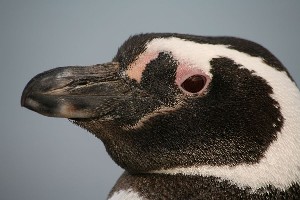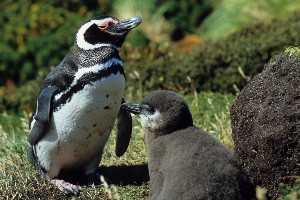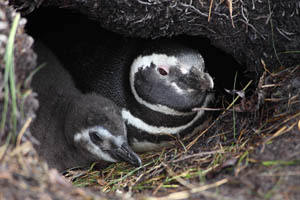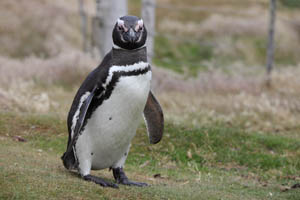
Magellanic Penguin |
 |
Specific Name: Spheniscus magellanicus | ||
|
|
|||
| Adult Height: 70cm | |||
| Adult Weight: 4kg | |||
| Adult Flipper Length: 18-20cm | |||
| Estimated Population: 2 Million |
Distribution / General : |
||
The Magellanic Penguin belongs to the Spheniscus genus of Penguins, along with the closely related African Penguin and the Humboldt and Galapagos Penguins. Populations of Magellanic penguins are distributed along the southern coast of Chile and Argentina (from Peninsula Valdez to Tierra del Fuego). Further smaller populations are found on the Falkland Islands. The main colonies are at Punta Tombo in Argentina (up to 250000 pairs) and Magdalena Island in Chile (up to 60000 pairs).No subspecies or subtypes are recognized.
|
Reproduction: |
||||||||||||||||||||||||||||||||||||||||
Magellanic penguins, unlike some of their spheniscid relatives, only attempt to breed once a year. The male returns to the colony to reclaim its usual burrow with the female returning later. Breeding tends to be with the same partner as in previous seasons and begins in September-October, depending on the longitude of the colony. Simple nests are built in burrows or small pits (often under bushes or between rocks) and 2 similar-sized eggs are laid within a period of 3-4 days. Incubation takes approx. 40 days.
After hatching, chicks remain on the nest until fledging, which can take from as little as 9 to as long as 17 weeks depending on food abundance. Mortality of the 2nd chick is higher and the first chick tends to be favoured by the parents, especially when food is limited.
After fledging, chicks often do not return to their natal colonies until the next breeding season, when yearlings can often be observed lying on or near the beaches. At this stage they are still easily distinguishable due to their juvenile plumage which lacks the distinct black and white striped markings of the adults.Once their chicks have fledged, adults head to sea for a number of weeks in order to forage and gain weight in preparation for the annual moult. The energetically demanding moult is required to replace the plumage which suffers wear during the course of the year.
|
General Behaviour: |
||||||||||||||||||
Magellanic Penguins are considered relatively aggressive and can inflict a strong bite if handled. Although they can be approached, they are wary of human presence. In many touristically accessible colonies, penguins have become somewhat used to human interaction and will only become visibly unsettled when approached closely. Birds may cock their heads from side to side as a warning signal or may in rare cases approach humans and bite them. Cessation of normal activity may also be indicative of disturbance in particular with nesting birds.Magellanic penguins, like their relatives, are relatively noisy and make a donkey-like braying noise (which gave the related Jackass Penguins their name).Magellanic Penguins are often seen performing the "ecstatic display". This can either be part of the mating ritual or can merely be indicative of territory ownership. Birds performing this display stretch their neck and point their beaks skywards whilst spreading their wings and making a braying noise. The display is often performed repetitively over periods of up to an hour or more.Magellanic penguins also perform allopreening (preening each other). This serves to reinforce bonds between penguins and to remove parasites, which are more abundant in the warmer habitats occupied by Spheniscus sp. penguins.Adult Magellanic penguins usually remain near their colonies at all times with only birds from the most southerly colonies moving to warmer waters during the winter period. Immature birds are less bound to the colony and tend to be found near food sources.
|
Threats: |
||||
Natural threats to adult Magellanic penguins include giant petrels and sea-lions. Eggs and young chicks can fall victim to various types of gull and in particular Skuas. Heavy rain can lead to the flooding of burrows and killing of young chicks which have yet to develop waterproof plumage. Burrows can collapse when trampled on by guanacos or cattle.
Human threats include pollution, such as spillage of oil. More significantly, overfishing of coastal waters can limit the available food supply and lead to high adult mortality and breeding failure. Birds may also become entangled in fishing nets.Overfishing is a particular problem on the Falkland Islands, where the irresponsible short-sighted local fisheries policy, allowing fishing in coastal waters near colonies, has led to and is still leading to a rapid decline in Magellanic (and other) Penguin numbers. Increasing anchovy fishing off the Argentinian coast could have a similar effect in the future.Magellanic penguins can nest successfully near human populations, yet studies have shown that the presence of humans does cause the birds stress (e.g. higher heart rate) even where access is regulated (e.g. the Punta Tombo colony). When food is plentiful, this is likely to have little impact, yet in times of food shortage the penguins may not be able to afford to waste any energy. |
Where To See: |
||||||
The largest Magellanic penguin colony that can easily be visited is the Punta Tombo colony south of Valdez Peninsula in Argentina. Not all of the colony is accessible and visitors must stick to the paths. However, due to the large number of birds breeding near or even sometimes on the paths, it is possible to see the penguins very easily at this location. Various other locations for viewing these penguins can be found along the coast of Southern Chile (e.g. Isla Magdalena), Argentina (e.g. Valdez Peninsula / Ushuaia Region) and on the Falkland Islands.Before trying to see any Penguin, please bear in mind that human interference (especially during the breeding season) is one of the problems faced by penguin populations. Positioning yourself between a nest and the sea may deter adult birds from returning to the nest and feeding the chicks. Magellanic penguins further often nest in shallow burrows which may collapse if walked over. Hence extreme caution should be taken in areas where Magellanic Penguins are breeding.
|
 |
 |
 |
||